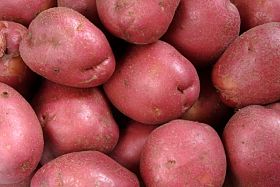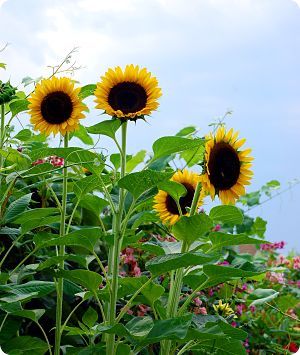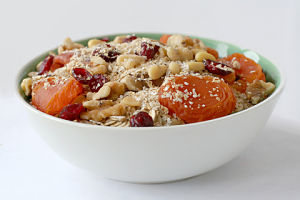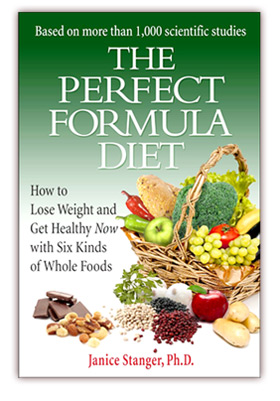Posts Tagged ‘vegetables’
Saturday, August 14th, 2010
Animals Are Nutrient Consumers

Plants are amazing nutrient factories. Consider how complex a tree is, with its functioning roots, trunk, branches, leaves, and flowers - all powered by sunlight.
Plants are the base of earth’s food chain, using solar energy to fuel nutrient manufacture. These green factories effortlessly put together the complex carbohydrates, fats, proteins, vitamins, and phytochemicals that animals need to survive and thrive. Plants also absorb minerals from the soil to weave into their own cells.
Animals who eat plants reap the benefits of these nutrients, needed for their own lives. With the exception of vitamin D, which forms in skin when sunlight hits it, animals cannot make the raw materials essential for their survival.
When you eat animal foods, you are consuming highly degraded remnants of (more…)
Tags: carotenoids, getting healthy, Janice Stanger, nutrition facts, Plant-based nutrition, vegetables, vitamin A, whole foods
Posted in Plant-based nutrition | Comments Off on Plants Are Nutrient Factories
Wednesday, July 28th, 2010
The American Heart Association Analyzes Which Lifestyle Programs Work
Cardiovascular disease (CVD) causes over one third of deaths in the US, killing an American every 37 seconds. Want to live an extra seven years? That would be the average increase in life expectancy if CVD was totally vanquished.

The American Heart Association wants physicians to be able to recognize and recommend effective ways to lose weight and exercise more.
To combat CVD, the American Heart Association (AHA) put dozens of researchers to work reviewing hundreds of studies on lifestyle change programs. The goal of this project was to identify the interventions that help people exercise more, lose weight, and eat healthier. The AHA summarized their findings in a 37 page scientific statement published July 12, 2010.
The AHA reinforced the role of activity, weight, and eating in preventing CVD. Their statement points out that black and Hispanic immigrants are initially at lower risk for this condition than US-born citizens in the same ethnic groups. However, as the immigrants adopt an American diet and sedentary lifestyle, CVD becomes a harsh reality for them. Since cardiovascular disease is so closely related to lifestyle and obesity, better habits could help prevent illness and death for everyone.
The AHA statement distilled ten strategies that can effectively change the way people think, act, and (more…)
Tags: American Heart Association, cardiovascular disease, getting healthy, goal setting, Janice Stanger, lose weight, Plant-based nutrition, process of change, vegetables, weight loss, whole foods
Posted in weight loss | Comments Off on Ten Strategies To Diet and Exercise Success
Wednesday, July 21st, 2010
Krista Watts Trades In Her Cat Allergies and Inhalers for Veggie Sandwiches

Krista and her wonderfully supportive husband Jeff are the picture of health and happiness
For nine years, Krista Watts needed to use an inhaler several times a day just to breathe. Her asthma overshadowed her life. Exercising was difficult, often leading to wheezing and a flushed face.
Krista’s asthma ordeal began after she adopted two cats. Tests led to the conclusion she was allergic to her new furry family. Unwilling to give up her much-loved pets, she resigned herself to living with a condition that was unpleasant at best, and life-threatening if it got out of hand.
For the last two and half years, though, Krista has not used her inhaler – not even once. She still has her cats, and plays with and pets them every day. Now age 38, she is amazed at her vigorous health and plummeting (more…)
Tags: asthma, cat allergy, getting healthy, Janice Stanger, Krista Watts, making a difference now, Plant-based nutrition, reverse chronic disease, vegetables, whole foods
Posted in Health | 1 Comment »
Sunday, July 18th, 2010
Steaming Potatoes Means a Cool Kitchen and High Energy

Red potatoes, purple, or Yukon Gold are all excellent for steaming. Cut into bite size pieces first.
Potatoes are one of nature’s most satiating foods. This means they get you full and keep you feeling full and satisfied longer than most other things you could eat. These nutritious spuds have gotten a bad name because they are usually made into chips or fried (read unhealthy and weight-promoting oil) or baked and smothered with a dairy topping. So it’s no wonder that potatoes have gotten a bad – but undeserved – reputation.
Baking and roasting are my favorite ways to make potatoes. In the heat of San Diego summer, though, the oven is best turned off. So I experimented with steaming potatoes and am cheering at the results.
First, I scrubbed and cut up about 10 medium sized Yukon Gold potatoes into (more…)
Tags: getting healthy, Janice Stanger, lose weight, nutrition facts, Plant-based nutrition, potatoes, vegetables, whole foods
Posted in Recipes | Comments Off on Summer Comfort Food that Keeps You Full
Sunday, May 23rd, 2010
Each Player on Its Own Can Do Little
No matter how well you eat, you may worry about your diet. You may doubt you are getting enough of certain nutrients. Iron, zinc,

With a superstar team, all players work together to win. Similarly, for whole foods, the benefit of all nutrients together is more than each taken on its own.
calcium, protein, omega-3 fatty acids…concern about these may hinder enjoyment of your food. Or maybe you are reluctant to begin a plant-based diet, because you are not sure if some critical nutrient is lacking.
We do not benefit from dissecting our foods into proteins, fats, carbs, calcium, iron, individual vitamins, and other components. The modern practice of taking food apart and worrying about each piece separately has led to bizarre eating patterns.
You may fret about lacking protein, or eating too many “carbs,” or not having enough “good fats.” So instead of eating whole foods, you then choose protein powder, neatly wrapped food bars, or bottles of oil. These foods narrowly focus on one or a few nutrients, leaving out most of the goodness of the entire plant.
Think of these manufactured foods as similar to a demolished building. You can live in an intact house, but won’t find shelter in a pile of bricks. Similarly, you won’t find the nutrients you need in (more…)
Tags: getting healthy, Janice Stanger, nutrition facts, Perfect Formula Diet, phytochemicals, Plant-based nutrition, vegetables, weight loss, whole foods
Posted in Plant-based nutrition | 1 Comment »
Friday, May 14th, 2010
A Whole Foods Diet Does Not Have to Be Bound to a Clock
Meal plans are a hallmark of most diets. You are expected to get hungry on cue, and wait until a specific time to eat again. If you

Soup is ideal for not-meals. You can eat a cup or a bowl, depending on how hungry you are.
are famished between meals, you might be allowed a small snack – probably not enough food to satisfy.
Meals are a human invention. These prescribed times to eat serve to carve up the day, leaving long stretches to be devoted to work. Everyone gets synchronized on pretty much the same rhythm. This may be good for societal functioning, but is not so good for your body.
Hunger is a fundamental instinct and need. Your ancestors, foraging in nature, undoubtedly ate when they were hungry and food was available. Wild animals, living as nature intended, will eat off and on the entire time they are awake.
Your naturally perfect body knows when you need fuel and nutrients. Our understanding of nutrition and physiological
functioning is still far from complete. To second guess your body’s signals to eat is a recipe for failure in the long-run, and often even in the short-run.
The Perfect Formula Diet eating plan urges you to eat when you are moderately hungry and stop when you are full. If you wait until you are famished to eat, you are far more likely to let your appetite get out of control. The end result is that you stuff yourself with too much (more…)
Tags: Janice Stanger, lose weight, not-meals, Perfect Formula Diet, Plant-based nutrition, vegetables, weight loss, whole foods
Posted in weight loss | 1 Comment »
Saturday, May 1st, 2010
Sodium Demonstrates That More is Not Always Better
In April, an Institute of Medicine (IOM) report once again highlighted the health consequences of eating too much salt. The report’s recommendation that the FDA should regulate salt in restaurant and processed food is news. Repeating information that the sodium in salt worsens high blood pressure merely reinforced what the majority of people likely already had heard.
The most important lesson hidden in the IOM report is the message that, in achieving ideal nutrition, more is not always better.

You can grind gourmet or specialty salt, but these have just as much sodium as regular salt
You may not realize that you do need some sodium, an essential mineral, in your diet.
When dissolved in a fluid (as it is in your body), sodium becomes electrically charged and is called an electrolyte. Sodium is essential for muscle and nerve function. If you lose too much sodium (for example, through heavy sweating), you may experience weakness, nausea, vomiting, cramping, and seizures.
Barring major sodium loss, you don’t need to worry about getting enough of this mineral. In fact, although the USDA recommends maximum amounts of sodium to eat, they do not even bother to suggest a minimum amount. You will get all the sodium you need on just about any reasonable diet.
Your kidneys actively regulate the amount of sodium and other electrolytes in your blood. When you eat too much salt, you make your body’s task of regulating these substances way more difficult, and health consequences may be serious. Cells are damaged by either too much or too little sodium in the fluid surrounding them. We all understand and accept the fact that, for salt, more is not always better. But you might not know that this general principle applies to all nutrients. The fact is, your body is an exquisitely delicate and complex system designed to work within narrow limits. Your body wants to maintain (more…)
Tags: getting healthy, high blood pressure, Janice Stanger, nutrition facts, Plant-based nutrition, salt, sodium, vegetables, whole foods
Posted in Plant-based nutrition | Comments Off on Limiting Salt to Just the Right Amount
Saturday, April 24th, 2010
A Garden Boosts Both Nutrition and Health
June can’t arrive soon enough for me. I signed up for an introductory permaculture class held June 2nd and 5th at San Diego Botanic Garden in Encinitas. Permaculture is an approach to growing food that works with nature. Instead of attacking and attempting to overpower nature – always futile and destructive in the long run – permaculture works in harmony with natural law.

Sunflowers combine the cheerful beauty of flowers with a delicious crop
The result is food for people and habitat for birds and wildlife.
Permaculture seeks to connect people and nature in a seamless web. Horticulture therapy takes advantage of this principle as well, This therapy treats a variety of patients and ailments using gardens and gardening. The lush colors and textures of plants is a welcome respite from a sterile, institutional health care setting.
For example, hospitals may bring patients into the outdoors to tend plants as part of their rehabilitation program. Elderly nursing home residents gain strength planting, weeding, and cutting flowers. Mental health settings can incorporate gardening into group therapy. Even Alzheimers disease patients become less anxious and more focused when engaged with nature.
You don’t need to wait until you are a patient to take advantage of the healing power of gardening. Growing plants is therapeutic for many reasons. First, and most obvious, is the exercise. Gardening may involve walking, lifting, bending, stooping, digging, and other physical tasks. Even tasks that are not strenuous add up when you do them frequently or over a (more…)
Tags: getting healthy, horticulture therapy, Janice Stanger, permaculture, Plant-based nutrition, San Diego Botanical Gardens, vegetables, whole foods
Posted in Green spaces | 1 Comment »
Saturday, April 17th, 2010
Useful News from the Vital Signs Workshop
Five pioneering researchers with one critical message shared their knowledge at the Vital Signs workshop on April 10, 2010. This event, put together by the awesome nonprofit Physicians Committee for Responsible Medicine (PCRM) was packed with compelling new information in nutrition and health.

A food as simple and tasty as oatmeal with fruit, nuts, and dairy-free milk will set you strong on the road to health
Here are highlights of five useful tips from each of the five presenters. If you missed the workshop and want to learn more, PCRM has generously posted the slides.
Lawrence H. Kushi, Sc.D. summarized the findings of thousands of studies.
1. The American Cancer Society emphasizes whole plant foods (including five or more servings daily of fruits and vegetables), exercise, and a healthy weight to prevent cancer.
2. The World Cancer Research Fund/American Institute for Cancer Research report reinforces the importance of a varied whole foods, plant-based diet, physical activity, and lean weight in preventing and fighting cancer.
3. This report also recommends avoiding red meat, processed meat, alcohol, and salty foods.
4. Eating lots of fruits, vegetables, and whole grains helps prevent obesity and weight gain.
5. It’s silly to put meat and beans in the same food group. You are best off just eating the beans. We (more…)
Tags: Dr. Dean Ornish, Dr. John McDougall, Dr. Lawrence Kushi, Dr. Mark Messina, Dr. Neal Barnard, getting healthy, Janice Stanger, lose weight, nutrition facts, PCRM, Plant-based nutrition, process of change, vegetables, Vital Signs workshop, whole foods
Posted in Plant-based nutrition | 1 Comment »
Sunday, April 11th, 2010
Prevent Wrinkles with Whole Foods – And Protect Your Health in the Process
Your skin, your largest and heaviest organ, mirrors the health of your body. Your 20 pounds or more of skin protect you, regulate body temperature, make essential chemicals, and allow you to feel touch, temperature, and pressure.

Changes in skin with aging are normal. Premature wrinkles, though, can be a marker for a poor diet.
The complexity of your skin is dazzling and important to appreciate. In just one square inch of skin you have about 500 sweat glands, 1,000 nerve endings, yards of tiny blood vessels for nourishment, 100 oil glands, 150 pressure sensors, and millions of cells. This intricate structure is separated into an inner and outer layer of skin. Each layer, in turn, has its own distinct architecture of many additional layers.
The deeper skin layer has both tough and stretchy protein fibers. As you age, your skin becomes thinner and less elastic. The protein fibers have less ability to bind water to keep your skin plumped.
Wrinkles form. While these marks of long life can be beautiful, the larger concern is that premature skin aging signals poor eating habits that can impair longevity and enjoyment of life. A diet rich in whole plant foods shields your skin from damage that can lead to wrinkling. Here’s why.
Radiation from the sun or a tanning booth causes free radicals to form. These are electrically charged particles that can damage cells in your skin.
Note free radicals emerge as part of normal metabolism, so all your cells (skin included) are bombarded by these hazardous particles even without (more…)
Tags: antioxidants, free radicals, getting healthy, Janice Stanger, nutrition facts, Plant-based nutrition, skin, vegetables, whole foods, wrinkles
Posted in Plant-based nutrition | Comments Off on Eat More, Wrinkle Less














